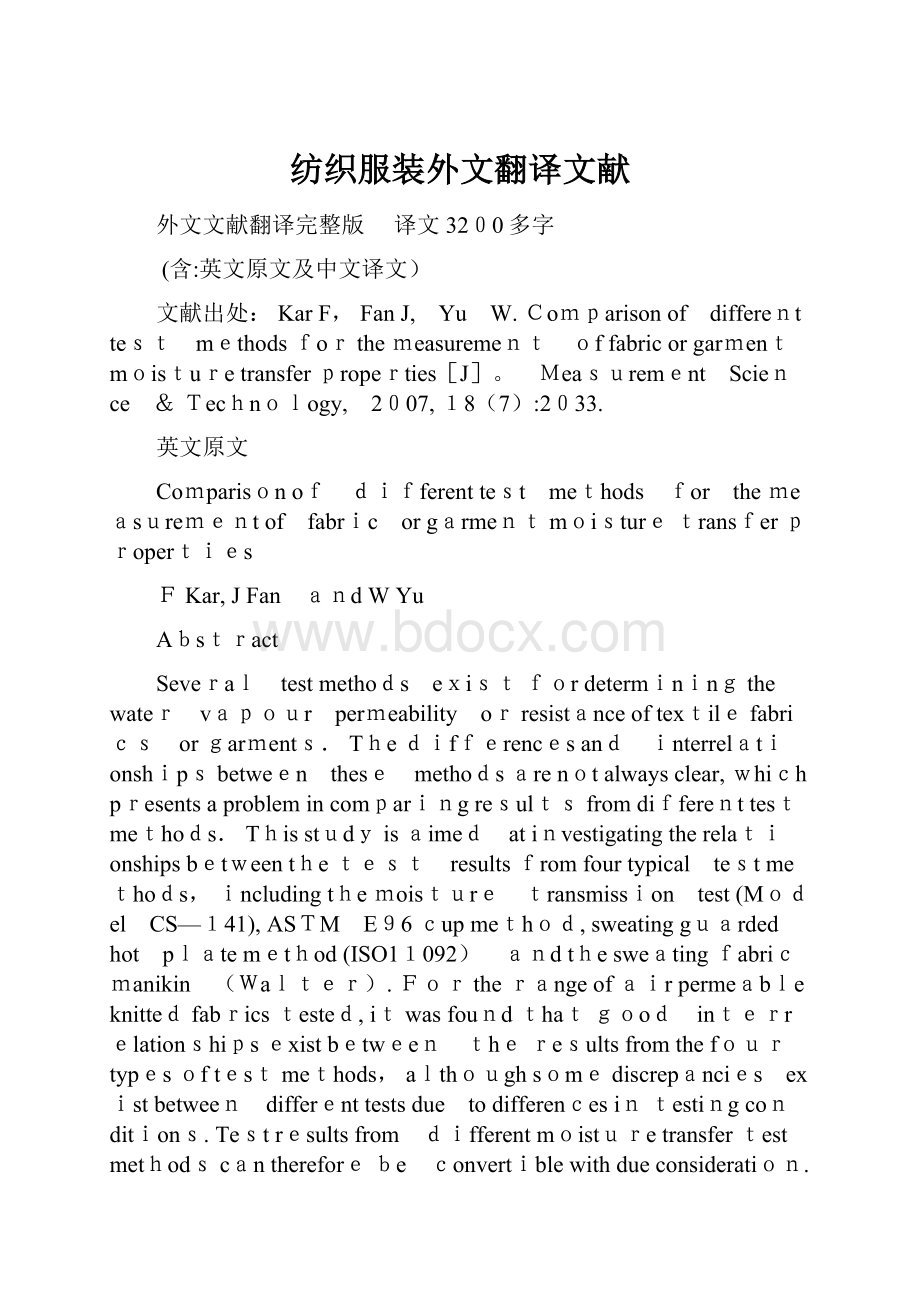 纺织服装外文翻译文献Word格式.docx
纺织服装外文翻译文献Word格式.docx
- 文档编号:22329321
- 上传时间:2023-02-03
- 格式:DOCX
- 页数:13
- 大小:34.31KB
纺织服装外文翻译文献Word格式.docx
《纺织服装外文翻译文献Word格式.docx》由会员分享,可在线阅读,更多相关《纺织服装外文翻译文献Word格式.docx(13页珍藏版)》请在冰豆网上搜索。

Measurement Science &Technology, 2007,18(7):
2033.
英文原文
Comparisonof differenttest methods for themeasurementof fabric orgarmentmoisturetransferproperties
FKar,JFan andWYu
Abstract
Several testmethods existfordeterminingthewater vapour permeability orresistanceoftextilefabrics orgarments.Thedifferencesand interrelationshipsbetween these methodsarenotalwaysclear,whichpresentsaproblemincomparingresultsfromdifferenttestmethods.Thisstudyisaimed atinvestigatingtherelationshipsbetweenthetest resultsfromfourtypical testmethods,includingthemoisture transmission test(Model CS—141),ASTM E96cupmethod,sweatingguarded hot platemethod(ISO11092) andthesweatingfabricmanikin (Walter).Fortherangeofairpermeable knittedfabricstested,itwasfoundthatgood interrelationshipsexistbetween theresultsfromthefourtypesoftestmethods,althoughsomediscrepancies existbetween differenttestsdue todifferencesintestingconditions.Testresultsfrom differentmoisturetransfertestmethodscanthereforebe convertiblewithdueconsideration.
Keywords:
fabric,water vapourtransmissionrate,clothingcomfort,water vapour resistance
1.Introduction
Moisturetransferpropertiesof textilefabrics andgarmentsareimportanttothe thermalcomfortof clothedpersons.Anumberoftestmethodshave been developedto evaluatethemoisture transferpropertiesoftextile fabrics andgarments.However, sincethetechniques and testingconditionsof thesetestsarevery different,results fromthesetests are notdirectlycomparable.Itistherefore necessary to investigatethedifferences andinterrelationshipsbetweentheresultsfromthesedifferenttestmethods.
Dolhancomparedtwo Canadian Standards(CAN2—4。
2—M77andCAN/CGSB-4.2No.49—M91)and the ASTME96 testmethodsformeasuringthewatervapour transmissionpropertiesandfound that theresultsofthesetestswere notdirectly comparablebecauseofthe differences inthewatervapourpressuregradientsdrivingthe moisturetransmissioninthedifferent test methodsGibson [8] conductedanextensiveinvestigationontherelationshipofthetestresultsfromthe sweating guardedhotplate (ISO11092) and those fromtheASTM E96Cup Method.Inhis work, permeablematerials, hydrophobicandhydrophilicmembranelaminates were testedandtheresultswerestandardizedinthe unitsof airresistanceand watervapourtransmissionrate.It wasfound, exceptforthehydrophilic samples, thereisa clear correlationbetweenthe resultsfromthetwotests。
Asthe testconditionintheguardedsweatinghotplatetestsresultedinmuch higherequilibriumwater contentinthe hydrophilicpolymer layer,which influencesthepolymer'
spermeability,thewatervapourtransmission ratethroughthehydrophilic membraneisgreaterwhentested usingthesweating guardedhotplate。
Aspointedoutbya number of previous researchers [7,12],differentrelative humiditygradients presentinthevarioustestmethodscause theintrinsictransportcharacteristicsofhydrophilic polymerstochange。
Forsuchfabrics,theretendtobepoor correlationsbetweendifferenttestmethods thatemploydifferingrelativehumiditygradients,sincethe resistanceis afunction ofthewatervapour concentrationandtemperature.Consequently,Lomax[11] pointedouttheneedfor investigatingthecorrelationsofresults fromdifferenttestmethodsfordifferenttypes offabrics.
Gretton etal[9]classified thefabric samplesintofourcategories,includingairpermeable fabrics,microporousmembranelaminated fabrics, hydrophilicmembranelaminated/coatedfabricsand hybridcoated/laminated fabrics, ininvestigatingthecorrelationbetweenthetestresults of thesweatingguardedhotplate (ISO11092)andthe evaporativedishmethod(BS7209)。
Theyshowed thatthereisa goodcorrelationbetweenthe two test methodsforallfabricsexceptforthe hydrophiliccoatedandlaminated fabricsthattransmit watervapour without followingtheFickian lawofdiffusion。
Recently,Indushekaretal[10]compared the watervapourtransmissionrates measuredbyamodulateddifferential scanningcalorimeterandthoseby theconventionaldish techniqueasspecifiedin BS7209 for awiderangeofwovenbased fabricsusedincoldweatherprotectiveclothing.Thestudyshowedthatresultsfrom these two testmethods differwidely dueto thedifferencesinthe water vapour gradientswhichoccurredinthe twomethods.
With thedevelopmentofnoveltechniques forthemeasurementof moisturetransmissionproperties offabricsandgarments,itis necessary tofurtherinvestigatetherelationshipbetween different testmethods。
Thepresentstudywasthereforeaimedatinvestigatingthecorrelationsbetween themoisture vapourresistances/transmission ratesmeasuredusingthe newlydevelopedsweating fabricmanikin(Walter)[4,6],the moisturetransmissiontest(Model CS-141) [1], theASTME96testingmethod[2]andthesweatingguardedhotplatemethod[5]. Since the correlationsbetweenthemoisturevapourresistances/transmission rates testedusing the differenttest methodsaregenerallydifferentfordifferentcategoriesof fabrics,thepresentinvestigationisfocusedonair permeablefunctionalT-shirt typefabrics
2。
Methods
2.1。
Samples
FourinterlockandfoursinglejerseyfunctionalT-shirtfabricswerechosenfromcommercialsourcesfortheexperiment。
Thesamplesrepresent typicalT—shirt fabricsinthemarket。
The fabricsweresewnintolong—sleevedT—shirtsforthe testsonthesweatingfabricmanikin (Walter)andthewearertrialexperiments.Table 1liststhecharacteristicsofthefabricsusedinthisstudy.
2.2 Experimental Measurement
2.2.1Moisture TransferTest Method(Model CS-141)
The instrumentmoisturetransfertesterusedinthistestwasdevelopedbyLudlow.The companyclaimsthatthisinstrumentcanquicklyandeasilydeterminethewater transferrate ofafabric。
Thistestisbasedon"gaspermeabilitylaw”.Thisrulerefers to themasstransferratioandtheabilityofthefabric toblock moisture penetration,thepressuredifferencebetween theupperandlowersidesofthefabric, andthe thicknessofthefabric. Figure1 showsthestructureofthemoisture transfertester.Smallenclosed watertanksTheclipsonbothsidessandwich the fabricsampleinthe middleofitsverticaldirection.Underneath thefabricisdistilledwater,whichis less thanhalftheheight ofthesink. Above is theairthathas been dried with desiccantat thebeginningofthetest.Theheightof theairgapbetweenthe surfaceof the waterin thetankandthelower surfaceofthematerialis10mm.Thetankwasplacedinachamberwithatemperatureof20°
Candarelativehumidityof 65%.During theexperiment,moisturewastransferred fromthe wetside(below thefabric)throughthefabricsample tothedryside(above thefabric)and thehumiditysensormaintainedthe monitoringofhumidity changesinthe upperpartof the tank。
Duringthetime whenthehumidityincreasedfrom50%to60%, theriseinrelativehumidity was recorded every 3minutes.The ratio of gasperhour perm2 ofsteamin terms ofgcanbecalculatedbytaking thedata into the equationbelow.
T=(269 ×
10−7)(Δ%RH×
60/t)(H)/(100 ×
0.02252)
(1)
Where:
Δ%RH-averageoftherelativehumiditydifferencebetween theupperandlower halves;
t-thetimeintervalbetweentwosuccessfuldatareads(t=3min);
H-watercontentperunitvolumeofthetank(H=45.74gm—3).
2. AmericanMaterialsandTestingAssociation E96verticalcupmethod
This methodis a verycommon method fortestingthemoisturetransferpropertiesoffabrics。
Thismethodcanbeusedtodeterminetherateof vapor-watertransportin theverticaldirectionofthefabricunder conditionsofconstantambienthumidity, constant humidityand aknownfabricarea。
Figure2showstheprincipleofthistest method.A cupfilledwith distilledwater coveredby fabricsamples wasplacedinan adjustableenvironmentwithatemperatureof 20°
Candarelativehumidityof 65%.Atthebeginningoftheexperiment,80 gof waterwas pouredintothecup, whichdeterminedthedistance fromthelower surfaceofthefabric tothewater surfacetobe19mm。
The testlastedforfive days,duringwhichtimethequalityofeachcupwasrecordedoncea day.Thevaporouswater transferrate(WVTR) per square meterperhourcanbe obtainedbytakingthedataintotheequationbelow。
WVTR=G /tA
(2)
Where:
G—thevalueofthechange intheweightof thecupcoveredbythefabric;
t—theduration ofthechangeinthe massofthe cup,measured inh;
A-theareaofthefabricsampletestedinm2。
2。
2.3.Newthermalresistancewet resistanceinstrument testmethod
Thenewthermalresistancewet resistanceinstrumentwasdevelopedbyFanet al.This instrumentcomplieswith the test requirements specifiedinISO(InternationalOrganizationforStandardization)11092.Compared withtheconventional heatresistanceand moistureresistanceinstrument,it makesit possibletosimultaneouslyperformsimulationtests onheatlossduetomoisture evaporationandmoistureevaporationloss。
Inaddition,theinstrument canbeoperatedat subzerotemperatures。
Figure3showstheconstruction andworkingprincipleof theinstrument。
Ascan beseen fromthemeasurementofevaporativeheatloss,thetotalmoistureresistance ofthefabricsampleplacedon the porous board,sandwichedbetweentheartificialskinandtheairlayercanbe obtained by takingthedata intothefollowingformula.
Easa ss etH )H—PA(P=R(3)where:
Ret-totalmoistureresist
- 配套讲稿:
如PPT文件的首页显示word图标,表示该PPT已包含配套word讲稿。双击word图标可打开word文档。
- 特殊限制:
部分文档作品中含有的国旗、国徽等图片,仅作为作品整体效果示例展示,禁止商用。设计者仅对作品中独创性部分享有著作权。
- 关 键 词:
- 纺织 服装 外文 翻译 文献
 冰豆网所有资源均是用户自行上传分享,仅供网友学习交流,未经上传用户书面授权,请勿作他用。
冰豆网所有资源均是用户自行上传分享,仅供网友学习交流,未经上传用户书面授权,请勿作他用。


 1212中级汽车维修工考试试题三.docx
1212中级汽车维修工考试试题三.docx
